

The Bamberg Horseman (German : Der Bamberger Reiter) is an early 13th-century stone equestrian statue by an anonymous medieval sculptor in the cathedral of Bamberg, Germany. It is the first of this kind since antiquity.


The Bamberg Horseman (German : Der Bamberger Reiter) is an early 13th-century stone equestrian statue by an anonymous medieval sculptor in the cathedral of Bamberg, Germany. It is the first of this kind since antiquity.
Dating probably from the time before the consecration of the cathedral's new building in 1237, but after 1225, it is located on a console at the north pillar of the St. George choir. It is not known whether this is the intended position of the statue, although the base appears to be original and the structure of the base would seem to dissuade moving. [1]
Being located in a church and showing a crowned yet unarmed man, it is believed that it represents a specific king, perhaps one who was a saint. A candidate is Emperor Henry II (973-1024) who is buried in the cathedral along with Pope Clement II, but he would likely have been depicted with Imperial Regalia. Another possibility is his brother-in-law, king Stephen I of Hungary (975-1038) who stops his horse and looks towards the tomb of Henry. Another theory favours Emperor Frederick II, the Holy Roman Emperor at the time, who financed much of the rebuilding of the cathedral. [2] Yet another theory, supported by Hannes Möhring of the University of Bayreuth, holds that the figure represents the Messiah according to the Book of Revelation (19:11–16). In 2014, an inventory of the statues in the cathedral gave rise to the theory that a project for a large sculptural screen for the eastern choir was begun and abandoned after only a few statues had been completed; two other unusual sculptures in the church fit into this proposal. According to the reconstruction, the horseman was supposed to be one of the Three Wise Men in a scene depicting the birth of Jesus, his upturned gaze following the Star of Bethlehem. [3] [4]
It is considered the first monumental equestrian statue since classical antiquity, and also one of the first to depict a horse shoe. Beneath the horse's front hooves is one of the many sculptural representations of the Green Man. Kathleen Basford, in her study of these figures, calls this Green Man the "dark counterpart" of the horseman.
Stefan George wrote a poem about the horseman. [5] His work influenced Claus Schenk Graf von Stauffenberg, [6] the would-be assassin of Hitler who was a member of the cavalry unit Bamberger Reiter- und Kavallerieregiment 17 (17th Cavalry Regiment). [7]

Bamberg is a town in Upper Franconia district in Bavaria, Germany, on the river Regnitz close to its confluence with the river Main. Bamberg had 79,000 inhabitants in 2022. The town dates back to the 9th century, when its name was derived from the nearby Babenberch castle. Cited as one of Germany's most beautiful towns, with medieval streets and buildings, the old town of Bamberg with around 2.400 timber houses has been a UNESCO World Heritage Site since 1993.
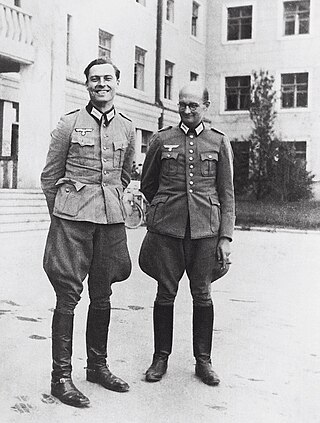
Claus von Stauffenberg was a German army officer who is best known for his failed attempt on 20 July 1944 to assassinate Adolf Hitler at the Wolf's Lair.
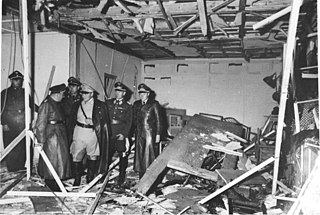
The 20 July plot was a failed attempt to assassinate Adolf Hitler, the chancellor and leader of Nazi Germany, and to subsequently overthrow the Nazi regime on 20 July 1944. The plotters were part of the German resistance, mainly composed of Wehrmacht officers. The leader of the conspiracy, Claus von Stauffenberg, planned to kill Hitler by detonating an explosive hidden in a briefcase. However, due to the location of the bomb at the time of detonation, the blast only dealt Hitler minor injuries. The planners' subsequent coup attempt also failed and resulted in a purge of the Wehrmacht.
An equestrian statue is a statue of a rider mounted on a horse, from the Latin eques, meaning 'knight', deriving from equus, meaning 'horse'. A statue of a riderless horse is strictly an equine statue. A full-sized equestrian statue is a difficult and expensive object for any culture to produce, and figures have typically been portraits of rulers or, in the Renaissance and more recently, military commanders.

Werner Karl Otto Theodor von Haeften was an Oberleutnant in the Wehrmacht who took part in the military-based conspiracy against Adolf Hitler known as the 20 July plot.
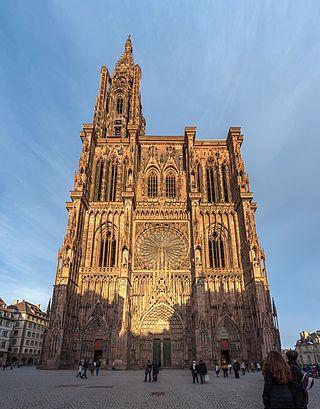
Strasbourg Cathedral or the Cathedral of Our Lady of Strasbourg, also known as Strasbourg Minster, is a Catholic cathedral in Strasbourg, Alsace, France. Although considerable parts of it are still in Romanesque architecture, it is widely considered to be among the finest examples of Rayonnant Gothic architecture. Architect Erwin von Steinbach is credited for major contributions from 1277 to his death in 1318, and beyond through his son Johannes von Steinbach, and his grandson Gerlach von Steinbach, who succeeded him as chief architects. The Steinbachs’ plans for the completion of the cathedral were not followed through by the chief architects who took over after them, and instead of the originally envisioned two spires, a single, octagonal tower with an elongated, octagonal crowning was built on the northern side of the west facade by master Ulrich Ensingen and his successor, Johannes Hültz. The construction of the cathedral, which had started in the year 1015 and had been relaunched in 1190, was finished in 1439.
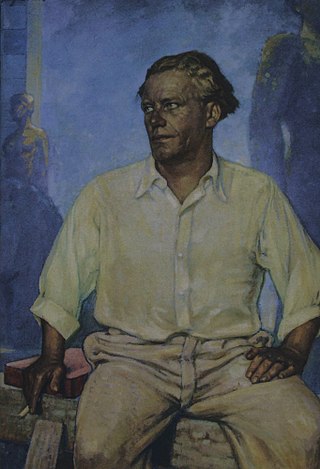
Josef Thorak was an Austrian-German sculptor. He became known for oversize monumental sculptures, particularly of male figures, and was one of the most prominent sculptors of the Third Reich.

Anton Dominik Ritter von Fernkorn was a German-Austrian sculptor.
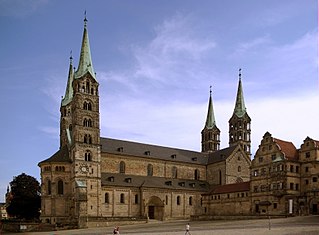
Bamberg Cathedral is a church in Bamberg, Germany, completed in the 13th century. The cathedral is under the administration of the Archdiocese of Bamberg and is the seat of the its archbishop. Since 1993, the cathedral has been part of the UNESCO World Heritage Site "Town of Bamberg".

The Monument to Nicholas I is a bronze equestrian monument of Nicholas I of Russia on St Isaac's Square in Saint Petersburg, Russia. It was created by French sculptor Auguste de Montferrand and unveiled on July 7 [O.S. June 25] , 1859, the six-meter statue was considered a technical wonder at the time of its creation. It is one of only a few bronze statues with only two support points.

The Monument to Peter I is a bronze equestrian monument of Peter the Great in front of the St. Michael's Castle in Saint Petersburg, Russia.

Valkyrie is a 2008 thriller film directed by Bryan Singer, written by Christopher McQuarrie and Nathan Alexander, starring Tom Cruise. The film is set in Nazi Germany during World War II and depicts the 20 July plot in 1944 by German army officers to assassinate Adolf Hitler and to use the Operation Valkyrie national emergency plan to take control of the country. The film was released by American studio United Artists and stars Cruise as Colonel Claus von Stauffenberg, one of the key plotters. The supporting cast includes Kenneth Branagh, Bill Nighy, Eddie Izzard, Terence Stamp, and Tom Wilkinson.
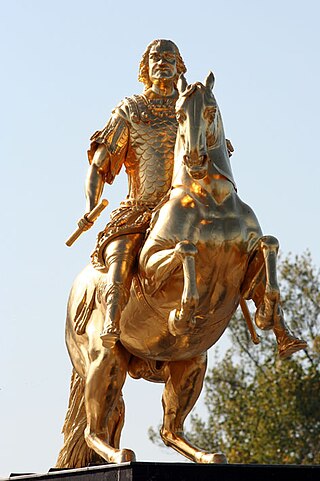
Jean-Joseph Vinache was a French sculptor who served as the court sculptor to Augustus II, King of Poland and Elector of Saxony. Vinache's equestrian monument of Augustus, known as the "Gilded Horseman", is one of the most familiar sights of Dresden, Germany.

The Equestrian Statue of Gattamelata is an Italian Renaissance sculpture by Donatello, dating from 1453, today in the Piazza del Santo in Padua, Italy. It portrays the condottiere Erasmo da Narni, known as "Gattamelata", who served mostly under the Republic of Venice, which ruled Padua at the time. It is the first full-size equestrian statue of the Italian Renaissance.

The Gunthertuch is a Byzantine silk tapestry which represents the triumphal return of a Byzantine Emperor from a victorious campaign. The piece was purchased, or possibly received as a gift, by Gunther von Bamberg, Bishop of Bamberg, during his 1064–65 pilgrimage to the Holy Land. Gunther died on his return journey, and was buried with it in the Bamberg Cathedral. The fabric was rediscovered in 1830, and is now exhibited in the Bamberg Diocesan Museum.
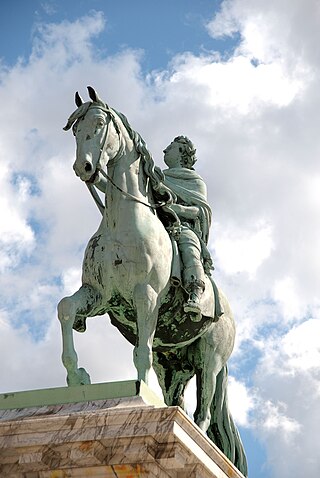
Danish sculpture as a nationally recognized art form can be traced back to 1752 when Jacques Saly was commissioned to execute a statue of King Frederick V of Denmark on horseback. While Bertel Thorvaldsen was undoubtedly the country's most prominent contributor, many other players have produced fine work, especially in the areas of Neoclassicism, Realism, and in Historicism, the latter resulting from growing consciousness of a national identity. More recently, Danish sculpture has been inspired by European trends, especially those from Paris, including Surrealism and Modernism.
Konstanze von Schulthess-Rechberg is a German author. She is the daughter of World War II colonel and resistance leader Claus von Stauffenberg.

A Carolingian-era equestrian statuette in bronze depicting either Charlemagne or his grandson Charles the Bald, a rare example of surviving Carolingian sculpture in metal, is exhibited in the Louvre Museum. In the 16th, 17th and 18th centuries it was kept in Metz Cathedral.